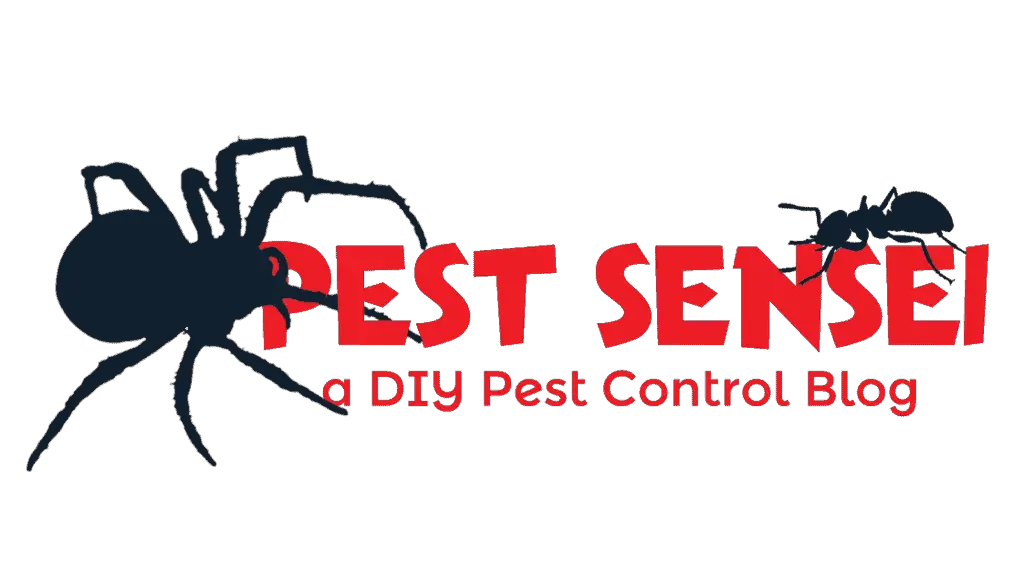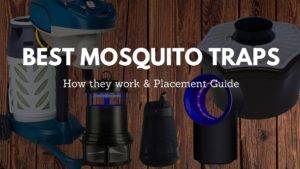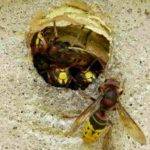Mosquito traps are popular devices used by many homeowners to combat mosquitoes. Do they really work? In this guide, I’ll explain the types of mosquito traps, how they work, how to make them effective, and the best mosquito traps to buy in 2023.
- How Mosquito Traps Work?
- How Mosquitoes Detect Their Hosts?
- Why Use Mosquito Traps?
- Where to Place Mosquito Traps?
- Improve Mosquito Trapping Efficacy by Pull and Push Strategy
- Best Mosquito Traps Outdoors
- Best Mosquito Traps Indoors
- Mosquito Traps for Community Use – Ovitrap and Gravitrap
- Additional Information
How Mosquito Traps Work?
Adult mosquito traps target host-seeking female mosquitoes. They use combinations of CO2, UV light, heat and chemical lures to attract mosquitoes. The trapped mosquitoes die due to desiccation and starvation.
Do note that mosquito traps will not solve your mosquito issue! It simply reduce the adult mosquito population, and subsequently the biting activity. If you need help getting rid of mosquitoes, do check out my guide on mosquito control.
How Mosquitoes Detect Their Hosts?
Mosquitoes can detect CO2 exhaled by their hosts using their sensitive sensors on their palps. As they approach their hosts, they are attracted by the body odor of the host.
Scientists have done a lot of tests to examine what exactly attracts mosquitoes. Two of the proven attractants found in human sweat are lactic acid and octenol. These 2 substrates are now the gold standards used as lures for most mosquito traps.
Not all products that contain lactic acid or octenol are effective to lure mosquitoes though. Because at a higher concentration, any attractants can become repellents.
Other than odors that make the mosquitoes go near their hosts, they also need to determine which object is their host, because there might be other objects nearby the host. For example, you might be sitting next to a rock. How would the mosquito know that she should land on you, not on the rock?
Mosquitoes have poor eyesight. After they fly near the hosts, they rely on contrast, movement, and heat to locate their hosts.
It was shown that dark color objects in bright backgrounds are more visible to the mosquitoes. The higher the contrast, the more visible the object to the mosquitoes. That’s why most mosquito traps are black in color.
While we tend to believe a person who stands still is more attractive to mosquitoes than a person who keeps moving, research has shown otherwise. It seems like mosquitoes are more attracted to something that moves, probably because a moving object is more likely to be a living animal.
Lastly, heat also helps mosquitoes identify their hosts. As early as 1910, scientists have proven that mosquitoes are attracted to warmer objects, presumably because most of their hosts are warm-blooded. However, that doesn’t mean mosquitoes don’t bite cold-blooded animals.
Why Use Mosquito Traps?
Mosquito traps are useful tool to reduce biting pressure around homes and businesses. They are non-toxic and work 24/7, unlike chemical treatments that require frequent reapplication. However, adult mosquito traps do not address the root of the problem: mosquito breeding.
Mosquitoes breed in standing water, so the best way to control mosquito populations is to eliminate their breeding grounds. This can be done by draining standing water, repairing leaky pipes, and emptying birdbaths and other containers.
If you are considering using an adult mosquito trap, it is important to use it in conjunction with other mosquito control methods. This will help to reduce the overall mosquito population and protect you from mosquito-borne diseases.
Where to Place Mosquito Traps?
The placement of the mosquito traps is important to ensure they do their job catching mosquitoes. Otherwise, not only are you wasting your money, you may even attract more mosquitoes to your house.
The mosquito trap should intercept incoming mosquitoes before they reach you. So, it should be placed either between you and the source mosquitoes, or at the source of the mosquitoes itself.
Below are some tips to help you find the right place for your mosquito trap. These are not product-specific advice. Certain products may have specific placement requirements due to their designs and specifications. So, make sure you read the label of the trap that you are using.
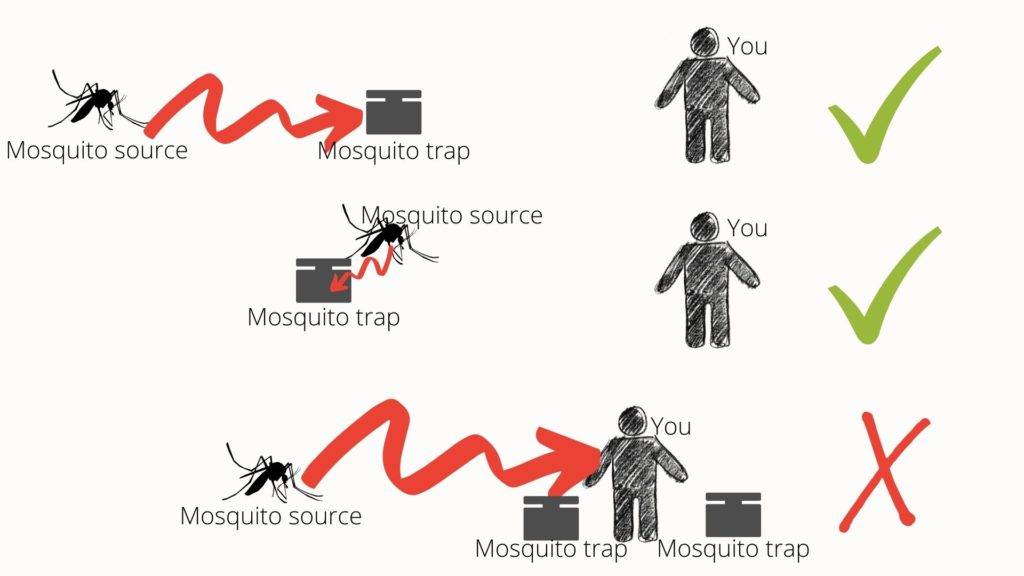
Away from you
I’ve not seen any mosquito trap that is as attractive to mosquitoes as a human. If you put a mosquito trap near you, I am sure the mosquitoes will land on you instead of going to the trap.
Ideally, you should place the mosquito trap 30-50 feet away from you to avoid competition with the trap.
Under shades and close to vegetation
Mosquitoes prefer shaded areas and dark places. You should place the trap under shades and close to vegetation, because that’s where most mosquitoes prefer to hide.
Protected from wind
Strong wind can disperse the odor of the attractant, diluting the lure and making it less effective. Moreover, mosquitoes dislike strong wind because it affects their flight.
Height of placement
Mosquitoes are weak fliers. To avoid being blown away by winds, they tend to fly close to the ground. So to increase the efficacy of your mosquito trap, it is best to place it on the ground level.
That doesn’t mean mosquitoes cannot fly into high-rise buildings. A research published in 2004 shows that mosquitoes released at the 12th story can move up to the 21st story to lay their eggs (the experimental site has 21 stories). Most likely, the mosquitoes fly upwards through the staircase and the elevator.
Improve Mosquito Trapping Efficacy by Pull and Push Strategy
The efficacy of adult mosquito traps can be enhanced by push and pull strategy. This involves using both repellent to push the mosquitoes away and attractants to pull mosquitoes into traps.
For instance, you can apply repellent (eg. Thermacell or mosquito coil) at your patio or anywhere you are having your activity. Meanwhile, set up some mosquito traps around your compound’s perimeter. Those traps become more appealing to the mosquitoes repelled from the patio, thereby increasing the catch rate.
Here is a guide on how to choose a repellent.
Best Mosquito Traps Outdoors
BG-Mosquitaire
BG-Mosquitaire is the most effective outdoors mosquito trap I’ve ever used. It is designed to catch mainly Aedes mosquitoes, but it does catch Culex, Anopheles and other mosquito species.
The Mosquitaire is designed based on BG-Sentinel, a gold standard mosquito trap used in scientific research. The key difference between the two is on the material, where BG-Sentinel is made of canvas, while Mosquitaire is made of high quality, durable plastic for domestic use.
So how does Mosquitaire work? There is a small fan in the Mosquitaire that blows out the lure to attract mosquitoes. As the mosquitoes detect the odor and fly near the trap, they are attracted by the black color funnel and fly toward the funnel.
Once they are near the funnel, the mosquitoes are sucked into the catch bag. The mosquitoes in the catch bag will die in 2-3 days due to desiccation and starvation.
Lure used in Mosquitaire is called the BG-Sweetscent, a patented formulation that mimics human odor. Each sachet of Sweetscent lasts you 1-2 months depending on the weather conditions. Warmer temperatures will disintegrate the Sweetscent faster.
Do note that after using the Sweetscent for 2-3 weeks, it will not smell as strong as it was when you open it from the sealed bag. That is normal. You don’t have to replace the Sweetscent because the mosquitoes can still detect the smell.
I’ve used Mosquitaire in private houses, country clubs, outdoor bars and schools. In one of the extreme cases, we caught close to 500 Anopheles mosquitoes over 1 week in a single trap; and in another location, we caught more than 200 Aedes mosquitoes in less than 5 days.
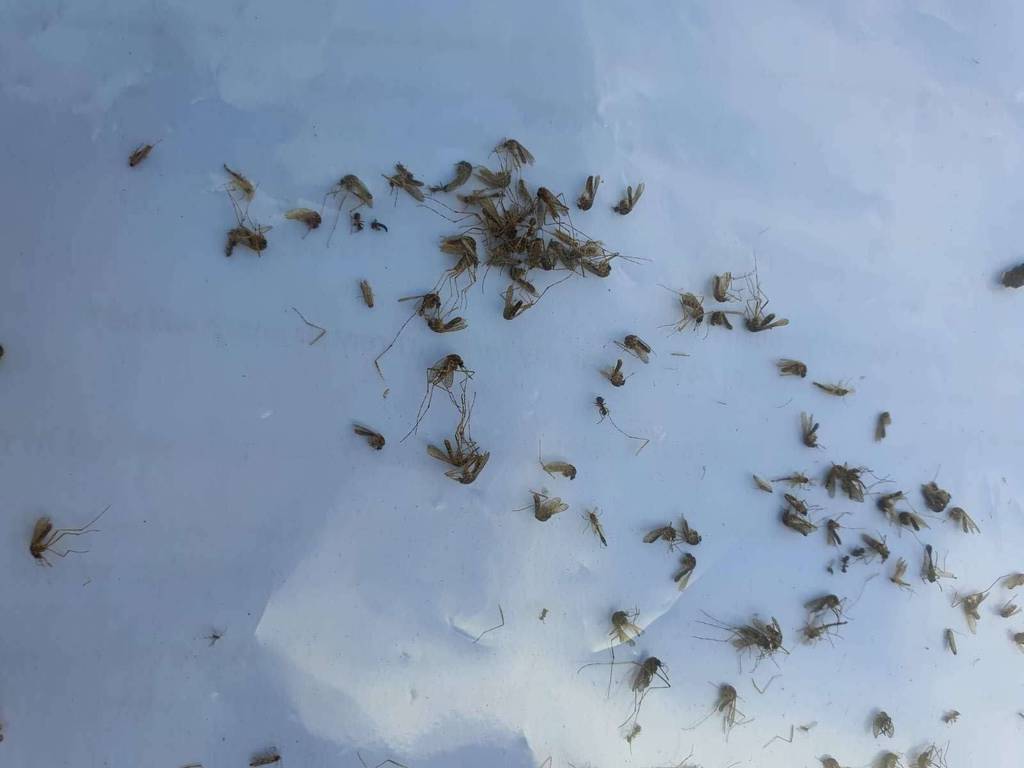
But there are occasions where the trap catches less than 10 mosquitoes in a month. The question is not how many mosquitoes it can catch, but rather how many mosquitoes are around. Of course, the correct placement is also crucial, as mentioned earlier.
Mosquitaire can be upgraded with a CO2 system to increase its efficacy and effective range. In most of the units I’ve installed, I don’t use CO2 (including the one that caught 500 Anopheles).
You should try Mosquitaire without CO2 first. Who knows, maybe you don’t need the CO2 to solve your mosquito problem. But do note that Biogents suggest using the CO2 system if you are targeting not only the Tiger mosquitoes.
Mosquitaire is not waterproof, but it is rainproof with an IP55 rating. Put it somewhere that will not be flooded when it rains, but never put it too high. Mosquitaire work best when placed at ground level.
Once every month or two, clean the catch bag. The catch bag should be filled with catches, leaves and debris. Due to the design of the trap, if you don’t clear the bag regularly, the efficacy will be reduced.
When you want to clean the catch bag, kill any surviving mosquitoes with your hands instead of spraying pesticide! Pesticide may have a repellency effect that affects the efficacy of your trap. Hand wash the catch bag with some mild dish detergent before putting it back.
You also need to clean both the fan and the white gauze (where the odor of the lure is blown out) once every 6 months or so to maintain the trap’s efficacy.
Highlight
- Uses odor, color, and CO2 (optional) to attract mosquitoes.
- Scientifically proven in peer-review research (canvas version).
- Do not attract other non-target insects.
- Easy to maintain.
- CO2 tank is optional.
- IOT-upgradable to monitor catches.
Lowlight
- Bulky size.
- Requires a power socket.
- Not the coolest-looking trap.
- On rare occasions, gecko, frog or snail may enter the catch bag.
Mosquito Magnet®
Mosquito Magnet is an outdoor mosquito trap that uses CO2, odor and visual cue to trap mosquitoes. In terms of efficacy, it is comparable to BG-Mosquitaire, but it is slightly more expensive.
Mosquito Magnet releases CO2 by burning propane. The CO2 gas disperses to the surroundings to attract mosquitoes. Upon detecting both the CO2, mosquitoes fly toward the trap, and the lure and heat produced by the trap attract them closer.
When the mosquitoes are close enough to the trap, the black color tube attracts them. As the mosquitoes approach the black tube, they are sucked into the trap. The mosquitoes captured will then die due to desiccation and starvation.
There are 2 options of lure that you can choose: ATRAKTA® containing a blend of lactic acid, octenol and ammonium bicarbonate, or octenol only. ATRAKTA® is recommended if you are staying in the southern part of the US where Aedes is predominant.
Once every 3 weeks, you will need to refill the propane tank and replace the lure. Take this opportunity to also clear the catch container. You should also clean the fan once every 6 months to make sure the suction is still strong enough to catch mosquitoes.
Personally, I don’t like using propane tanks because they are flammable. But that doesn’t stop me from recommending Mosquito Magnet because it is truly effective.
Highlight
- Uses odor, color, heat, and CO2 to attract mosquitoes.
- Scientifically proven in peer-review research.
- Do not attract other non-target insects.
- Easy to maintain.
- Big coverage.
- Cordless version available.
Lowlight
- Bulky size.
- High initial investment cost.
- Expensive to maintain.
- Requires the use of propane tank.
Best Mosquito Traps Indoors
While indoor mosquito traps may have their merits, I personally hold reservations about their effectiveness. Given that many of us spend a significant amount of time indoors, we inadvertently become competitors with the mosquito trap in attracting these pests. However, it is crucial to note that indoor mosquito traps can indeed prove effective under specific circumstances.
Mosquito Home
Mosquito Home is a product by Biogents. It specifically attracts mosquitoes through a combination of cues including heat, contrast and odor.
Unlike most indoor traps that utilize only LED light, Mosquito Home doesn’t attract flies, flying ants, midges, moths, beetles and other flying insects. This may result in the impression where Mosquito Home has a lower catch rate than competing products. However, it is important to consider only mosquito count when evaluating the efficacy of mosquito traps.
Mosquito Home has a clever design on its lid. As soon as the device is powered off, the lid will close by itself to prevent mosquitoes from escaping.
Place Mosquito Home in rooms during the peak biting hour. This can be day time for Aedes mosquito, and night time for other night-biting species. Make sure no one is occupying the room where the trap is placed to avoid competition. As mentioned, no traps can out-compete a real human.
Mosquito Traps for Community Use – Ovitrap and Gravitrap
Ovitraps and gravitraps are another category of mosquito trap. They are meant for community use.
Ovitraps or gravitraps target mosquito breeding. They attract egg-laying mosquitoes by the presence of water, its color, and sometimes chemical lure. They usually contain larvicide that kills the hatched larvae.
Certain ovitrap traps have sticky glue to catch the adult mosquitoes, while others may kill them with adulticides.
Ovitraps or gravitraps are cheap to maintain, and can reduce the mosquito population if used at large scales. The caveat is, ovitraps target only container-breeding mosquitoes, which are the Aedes mosquitoes. It doesn’t help if you are facing issues from Culex or other mosquito species.
From the users’ perspective, adult mosquito traps kill mosquitoes before they bite, while ovitraps kill mosquitoes after they bite. No one wants to get bitten, and that’s why most people prefer to use adult mosquito traps.
If you are looking for mosquito traps for community use on a large scale, you should look for effective and yet affordable ovitraps or gravitraps that target mosquito breeding. Below are the 2 traps proven effective when used in large scales to control mosquito populations.
I have to stress that these traps work if deployed on a large scale. It doesn’t work if you are the only one using them in your community.
Inzecto Mosquito Trap
Inzecto Mosquito Traps is a gravitrap that kills both the egg-laying female Aedes mosquitoes, their larvae and pupae.
The inner wall of the trap is coated with permethrin to kill any mosquitoes that land on it to lay eggs. If the eggs laid by the mosquitoes hatch into larvae, they are killed by pyriproxyfen in the trap. Pyriproxyfen affects both larvae and pupae by hindering their molting process.
While both permethrin and pyriproxyfen are harmful to other insects and aquatic animals, Inzecto is considered safe because the pesticides are contained within the trap. Moreover, the traps don’t attract the beneficial insects. So, the chances of killing non-target animals is low.
Aside from its proven efficacy, I like Inzecto because of its ease of use. You only need to add water, and that’s it! You don’t need to handle any pesticide because the pesticides are coated on the inner wall.
The slow-release pesticide coated on Inzecto can last for 3 months. After that, you will have to collect it and replace it with a new one.
In2Care Trap
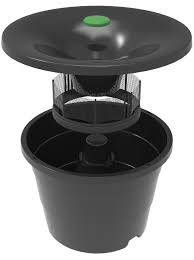
In2Care Traps is a gravitrap that kills both the egg-laying female Aedes mosquitoes and their larvae and pupae. The most exciting feature about In2Care is the auto dissemination of pyriproxyfen to surrounding breeding grounds.
In2Care’s consumable is called the In2Mix. It contains both Beauveria bassiana and pyriproxyfen.
B. bassiana is a natural-occurring entomopathogenic fungus. It kills a number of insects including mosquitoes, termites and bed bugs. It is considered safe because it rarely infects humans or animals.
On the other hand, pyriproxyfen is a larvicide that targets larvae and pupae of the mosquitoes. It kills the mosquito immatures by interfering with the molting process.
When a gravid mosquito detects the In2Care and lands on the mesh to lay eggs, it picks up both the B. bassiana and the pyriproxyfen, thanks to the electrostatic net in the trap. The fungus kills the mosquitoes within a few days, while the pyriproxyfen is harmless to the adult mosquitoes. The eggs laid will hatch in the water, but the immatures are killed by the pyriproxyfen.
Aedes mosquitoes exhibit a behavior called skip oviposition, where the mosquitoes will lay eggs in multiple breeding grounds instead of “putting all eggs in one basket”. When the pyriproxyfen-contaminated female mosquitoes fly to another breeding ground, it contaminates that breeding ground with pyriproxyfen. Essentially, it means the mosquitoes help you treat all breeding grounds! And they are better than us in doing this, because they can find breeding ground that we couldn’t find.
In2Care has been trialed in Florida and proven to work as it claims in terms of killing the adult mosquitoes, contaminating nearby breeding grounds, and reducing the mosquito emergence from the affected breeding ground. Although it was meant to target Aedes mosquitoes, a field trial conducted in California shows it attracts and kills Culex mosquitoes too.
The only complaint I have is the installation of netting. It’s not difficult, but it’s not the easiest thing to do either. You have to replace the insecticide-impregnated net every month.
Additional Information
Do UV Light Mosquito Traps Work Outdoors?
UV light mosquito traps work mainly for night-biting mosquitoes, but they are not as effective as baited traps. Moreover, it targets all sorts of flying insects. It is common to have more insects other than mosquitoes trapped in UV light traps, if you use them outdoors.
Should I Use Bug Zappers to Kill Mosquitoes?
No you should not. Bug zappers kill more non-target insects than mosquitoes. Zapped insects may break into fine pieces that float in the air, causing health issues if inhaled, and can contaminate food.
Does Titanium Dioxide Photocatalytic Reaction Produce Carbon Dioxide to Attract Mosquitoes?
Maybe. TiO2 is commonly coated on self-cleaning glasses to break down organic pollutants into water and CO2. However, I doubt the amount of CO2 produced by TiO2 in a mosquito trap is significant to increase the efficacy of the mosquito trap.
